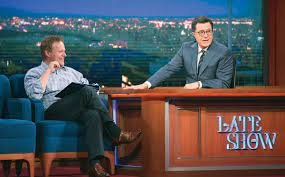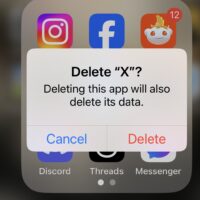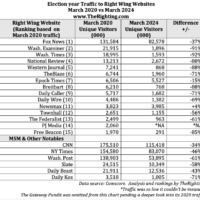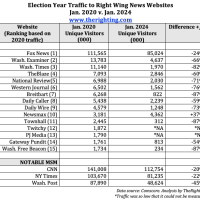
Late-Night Gabfests Still Shape Political Discourse
By J. Max Robins
The impact of the late night talk shows like “The Late Show” on political discourse will continue to be huge despite some softness in the genre. Colbert (above right), Fallon and Kimmel have tens of millions of followers on Twitter and Instagram, as well as millions of subscribers to their YouTube channels that magnify their real-time impact exponentially. (Photo: Wikimedia)
From the right, left and in-between, the death bells are tolling for late-night TV. A recent New York Times feature plaintively asked: “Is There a Future for Late-Night Talk Shows?” It’s a good question. In the wake of Trevor Noah’s surprise announcement that he would leave his prime perch at Comedy Central’s The Daily Show, National Public Radio TV critic Eric Deggans opined that Noah’s “departure hints at deeper problems” in the genre. And Puck’s Dylan Byers struck a more fatalistic note about what’s programmed after 11 p.m., in a piece emblazoned with the headline “A Tree Falls in Late Night.”
Naturally, Donald Trump claimed to be the one-man firing squad that took the genre out. “It was my great honor to have destroyed the ratings of Late NIght ‘Comedy’ shows,” Trump wrote on his Truth Social site last week. “When Jimmy Fallon apologized for having humanized ‘Trump,’ and his ratings soared, the Radical Left forced him to apologize—that was effectively the end of The Tonight Show.”
Given the long importance of late night shaping the national political and cultural conversation, all the gallows chatter, especially from The Donald, is understandable. It comes on the heels of a shake-up that’s been going on for more than a year. Noah was simply the latest star to bail on the nightly grind. The exodus of this era’s hosts began with Conan O’Brien, a late-night staple for 30 years, who exited his TBS show in June 2021. Several others have left the couch and patter behind in recent months, including TBS’ Samantha Bee, CBS’ James Corden and Showtime’s Desus & Mero. Meanwhile, the genre’s big brands – NBC’s Jimmy Fallon, ABC’s Jimmy Kimmel and CBS’ Stephen Colbert – have all seen ratings dip, and revenues with them.
Not Dead Yet
Yet the impact of the shows on public opinion and political discourse will continue to be huge, and there may even be opportunities for growth. Fallon, Kimmel and Colbert have tens of millions of followers on Twitter and Instagram, as well as millions of subscribers to their YouTube channels that magnify their real-time impact exponentially.
Last September, for example, Colbert released a clip entitled “We Predicted Every Insane, Criminal Step Down Nutball Highway to Jan. 6th”, which played like a dishonor roll of bits chronicling Donald Trump’s election denialism and its instigating part in the violent assault on the United States Capitol. It was seen by more than 2.5 million viewers, and that’s anything but an outlier. A Later with Seth Myers segment that aired after last Thursday’s Jan. 6th congressional insurrection hearings had already clocked more than 700,000 YouTube views by 9 AM Friday. {Note to Trump: Jimmy Kimmel’s acidic rebuttal to your claims got hundreds of thousands more views than your wannabe executioner Truth Social post.}
An Urgent Need For More Diverse Voices
Much of the reporting on the alleged late-night crisis has justifiably decried that the hosting chairs are mostly filled by white, middle-aged men. Thankfully, in recent years, several immensely talented women have entered the fray, such as Bee, Chelsea Handler’s long-gone Chelsea Lately on the E! Network and Sarah Silverman’s I Love You America on Hulu; those last two didn’t have the support to go the distance. The Amber Ruffin Show, which debuted two years ago on NBCUniversal’s Peacock streaming service, has gotten strong critical notices for being the lone woman duking it out in the night talk arena.
This lack of diversity in late night is a huge problem; one that may offer a big opportunity. For example, Ruffin is certainly worthy of a bigger platform. Is there potential space on MSNBC for her in the late-night hours? Why not? There’s been industry chatter about moving NBC’s Late Night with Seth Meyers over there.
Before business differences between the duo ended their Showtime run, Desus Nice (Daniel Baker) and Kid Mero (Joel Martinez) built a strong following with young audiences, grabbing big political gets, including Alexandria Ocasio-Cortez and Barack Obama. The duo’s demise has left an important gap to be filled. And counter-programming was part of Trevor Noah’s success some nine years ago, when he took the reins of The Daily Show from the iconic Jon Stewart. Talk about a tough act to follow; and yet, Noah made the Comedy Central franchise his own, resonating with an audience that was younger and more diverse than Stewart’s flock. Still, he didn’t stray too far from the formula. Stewart was long our left-leaning political sanctuary, the late-night prophet (for profit) who was indispensable during election seasons. That’s another issue with the gap in current programming for the night time talkers; as the midterms near, we hunger for sane voices.
Speaking of which, much has been made of the fact that Fox News’ always mean, seldom funny right-wing talkfest The Greg Gutfeld Show sometimes draws a bigger crowd then the variously leftward leaning Big Three competition. As much as I may hate to admit it, Gutfeld’s success zagging unapologetically ultra-right from the establishment competition is a lesson in how to serve an audience that has been neglected.
A Lingering Hunger
Given the current landscape with the rise of the likes of Gutfeld, and the exit of so many funnier talents, it’s no wonder that Bill Carter, who wrote the 1995 classic TV tome: “The Late Shift, Letterman, Leno & the Network Battle for the Night,” declared in an August CNN piece that “late-night television’s golden age [is] over.” Obviously, we have traveled light years from that simpler, if uglier time when David Letterman and Jay Leno were late-night titans of the Ali vs. Frazier variety, trading jabs and rounds of ratings points. Much like what happened to the heavyweight boxing division, the late night landscape is now flattened wide and light on distinct voices. Add to that the ubiquitous streaming services, as well as an unprecedented amounts of TV on-demand to woo us.
Maybe that’s why a hunger lingers in late night for diverse, sharp, funny commentary on the state of our union and beyond, and from a bigger seat. Some network or streaming service is bound to see the potential. Maybe then we’ll have a new The Greatest in late night.
J. Max Robins (@jmaxrobins) is executive director of the Center for Communication. The former editor-in-chief of Broadcasting & Cable, he has contributed to publications, including the Wall Street Journal, Columbia Journalism Review and Forbes. Read more from J. Max Robins at his website.
Interested in more news about right-wing media curated especially for mainstream audiences? Subscribe to our free daily newsletter.
























